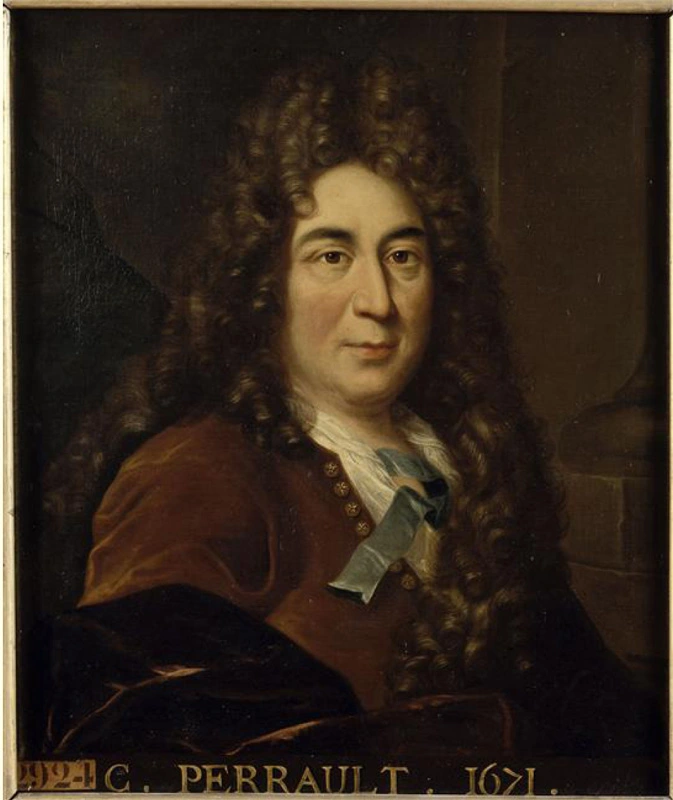Fortunately for Perrault’s reputation, perhaps, this work was never published and has not survived. He subsequently
developed some sense and taste, and his new poems, particularly the ‘Portrait d’Iris’ and the ‘Dialogue entre l’Amour et l’Amitié’ were well
received by his contemporaries, who considered them charming. They were published anonymously, and Philippe Quinault, himself a poet with an established reputation, used some of them to press his
suit with a young woman, allowing her to believe that they were his own. When Perrault was told about this, he revealed himself as the author of the poems, but when he heard about how his work had
been used, he decided not to come forward. He forgave the fraud that had been perpetrated and he and Quinault became friends.
The next profession to engage Perrault’s attention was architecture. In 1657 he designed a house at Viry for his brother and supervised its construction. Louis XIV’s finance
minister, Jean-Baptiste Colbert, was so impressed that he employed Perrault as superintendent of the royal buildings, and put him in special charge of Versailles, then in the process of
construction. Perrault threw himself enthusiastically into this work, although not to the exclusion of his other activities: he wrote odes in honour of the king; planned designs for Gobelin
tapestries and decorative paintings; became a member of the Academy of Medals and Inscriptions, founded by Colbert to devise suitable inscriptions for the royal palaces and monuments; encouraged
musicians and lent his support to the court composer Jean-Baptiste Lully, who was at the centre of several romantic scandals. He also teamed up with his brother Claude in a successful initiative to
found the Academy of Science.
Claude Perrault had something of Charles’s versatility and shared his love of architecture, and the brothers now became very involved in the various schemes that were mooted for the
completion of the palace of the Louvre. The king summoned the sculptor Bernini from Rome and entrusted him with the task, but the Perrault brothers intervened. Charles conceived the idea of the
great eastern elevation, while Claude drew the plans and was commissioned to execute them. The work was completed in 1671, and it is still popularly known as Perrault’s Colonnade.
In 1671 Perrault was also elected to the French Academy, an honour that, unusually, was bestowed without any canvassing by him on his own behalf. His inaugural address was greeted with such
enthusiasm that he suggested that the inauguration of future members should be a public function. His suggestion was adopted, and these addresses became the most famous feature of the
Academy’s proceedings, as they still are today. This was not Perrault’s only service to the Academy – he successfully proposed a motion to the effect that future elections should
be effected by secret ballot, inventing and providing (at his own expense) a ballot box, which, although he doesn’t describe it, was probably the model for those in use in clubs and societies
today.
The originality of his views did not always endear him to his brother Academicians, the ‘Immortals’. His poem ‘Le Siècle de Louis XIV’ gave rise to one of the most
famous and protracted literary quarrels of the era. In praising the writers of his own day Perrault dared to disparage some of the authors of the ancient classics. The poet and critic Nicolas
Boileau worked himself into a furious opposition, hurling insults at Perrault. The somewhat more subtle Racine pretended to think that the poem was a work of ingenious irony. Most of the
Academicians joined the fray. There is no doubt that Perrault’s position was untenable, but he defended himself with good humour and wit. As a result, the violence of Boileau’s
reaction, and his obvious desire to display the extent of his learning, simply made him look absurd. Perrault states the Modernist case in Le Parallèle des Anciens et des Modernes, published
in four volumes in 1688–96. He clearly took more pride in this dull and now almost forgotten work than in the incomparable stories that have made him famous.

Portrait of Charles Perrault (1628-1703)
Contrôleur général des Bâtiments du roi, membre de l’Académie française Paris, palais de l’Institut
© RMN / Droits réservés
After 20 years in Colbert’s service, the sun was beginning to set on Perrault’s fortunes. His brother Pierre, the Chief Commissioner of Taxes, had a dispute with Colbert and resigned
in disgrace. Then Perrault became engaged to a young woman of whom nothing is known except that Colbert opposed the match. (At this time Colbert’s own influence with the king was waning, and
this was having an adverse effect on his mood.) It was in Perrault’s nature, that although he was a courtier, he could be relied on to consider the wishes of nobody except himself and his
future wife and he refused to break the engagement. He slipped quietly from Colbert’s service in 1683, at the age of 55.
However, before he left the court, he succeeded in frustrating an initiative that would have closed the Tuileries Gardens to the people of Paris. Colbert wanted to have them reserved for the use
of the king, but Perrault persuaded him to come for a walk with him there one day so that he could show him the people taking the air and playing with their children. He had the gardeners declare
that these privileges were never abused, and drove home his point by declaring that the gardens were ‘so spacious that there was room for all [the king’s] children to walk
there’.
In the nineteenth century the literary critic Charles Sainte-Beuve proposed that this service to the children of Paris should be commemorated by a statue of Perrault in the Tuileries Gardens.
The statue was never erected, and to this day Paris, although plentifully endowed with statues and portraits of the great men of France, has none to show that she appreciates the genius of
Perrault.
1 comment